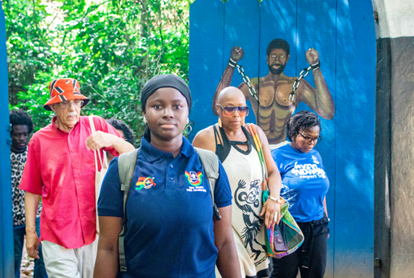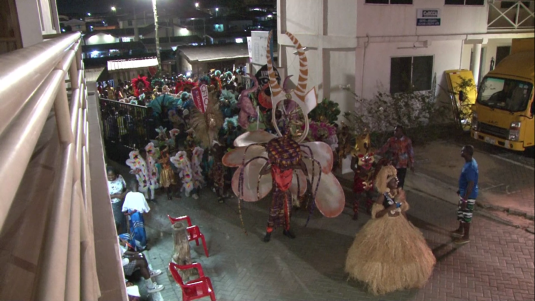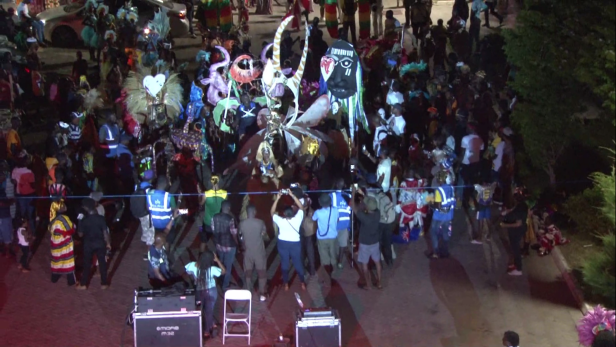Unmasking Decolonization: Exploring the Power of Masquerade and Carnival Arts in Promoting African Practices and Peacebuilding
.png)
Introduction
The 10th International Conference of Carnival & Masquerade Arts, situated in the context of the Decolonization Education for Peace in Africa (DEPA), took place on 4-8th December 2023 at the University of Education, Winneba. It was the first ever edition to take place in Africa since its birth in 2006. The earlier editions took place in London from 2006 to 2021 and Oxford (2022). The School of Creative Arts (SCA) and Centre for Research in Culture and Creative Arts, (CeRRCA), at the University of Education, Winneba hosted the programme in collaboration with the Peace and Conflict Department, Faculties of Cultural Affairs, History & Cultural Studies, and Fourah Bay College, University of Sierra Leone, Freetown.
Themed Rhythm of a People: Tradition, Connection, Innovation and Decolonisation, this landmark conference participants the opportunity to exchange knowledge and share experiences and practices around multiple themes. The conference affirmed and celebrated shared creative cultural heritage expressions and traditions, with Carnival and Masquerade art practices.
The conference brought together scholars, artists, activists and community members from across the globe to explore the significance of carnival and masquerade traditions in decolonization and peace-building. Carnival and masquerade arts have long been integral parts of African culture, serving as a vehicle for self-expression, resistance, and communal celebration. In the context of the DEPA project, these traditions take on added significance as tools for reclaiming cultural identity, challenging colonial narratives, and fostering intercultural understanding.
.png)
Captivating young participants during the parade.
Opportunities for promoting Winneba Fancy Dress Culture and the University
This conference brought together, academic researchers, African and Caribbean visual arts and masquerade practitioners, calypso, steelpan, and traditional master drummers and percussion musicians, DJs, filmmakers and members of African Chieftaincy houses and communities, Caribbean carnival organisations and universities from the UK, Africa, the Caribbean, and America.
It was a great opportunity for Winneba Fancy Dress cultural entrepreneurship, advertisement and knowledge sharing. Besides, contributing to the academic visibility of the University of Education, Winneba considered the large number of participants who through the conference visited Ghana and the University for the first time. The programme in one way or another created a formidable internationalisation platform in that regard.
Project Methodology
Due to the nature of the project, it was sectioned into three major phases. Phase 1 collected data from participants who partook in the dungeon visit to the Cape Coast castle. This offered them the opportunity to share their experiences with the told narratives about the slave trade activities, physical infrastructure and the precarious conditions the enslaved were taken through by the colonialists. Semi-structured interviews constituted the data collection instrument used in collecting the said data at this Phase. Phase 2 of the project focused on presenters’/delegates’ experience of the conference while Phase 3 sought data concerning carnival workshop trainers/participants. The main instrumentation for the research project was an observation checklist, interviews, video documentation and presented papers.
Three key research questions the study hinged on were:
- How do Masquerade and Carnival arts promote and preserve African/neo (new) African practices to engender decolonisation?
- In what ways can Carnival and Masquerade arts be used to address contemporary issues of peace and conflict?
- How can carnival and masquerade arts empower, sustain and contribute towards individual’s agency and their role(s) as peacebuilders and negotiators of conflict resolution?
Discussion and analysis of these three key questions are ongoing. That notwithstanding there have been some individual published research articles centred on the theme of the conference. Dr Johnson Edu and Dr Latipher Amma Osei have their articles published.
Activities
1. Visits
Assin Manso slave river site (where the enslaved had their last bath)
A visit to the Assin Manso slave river site and the Cape Coast (Figures 2 and 3) set the stage for the beginning of the project. The powerful reminder of the transatlantic slave trade and its impact on African cultures and societies was a pivotal moment that underscored the urgency and significance of the DEPA project. Walking through the dungeons and witnessing the haunting remnants of this dark period in history served as a stark of the need to address the legacies of colonialism and slavery in Africa.


Participants visiting the Assin Manso Slave River Site.
Cape Coast Castle and the "Door of Return"
The emotional and educational experience at the Cape Coast Castle deepened the resolve of the project’s participants to embark on a journey of decolonization education for peace in Africa. It illuminated the importance of embracing and amplifying African cultural traditions such as carnival and masquerade arts as vehicles for healing, empowerment, and reconciliation.
The profound impact of the visit to the Cape Coast castle informed the ethos and trajectory of the DEPA project, shaping its vision and guiding principles. This experience influenced the insights and discussions at the 10th International Conference, providing a foundational framework for the integration of Carnival and Masquerade Arts in decolonization education for peace in Africa.


Participants touring the Cape Coast Castle
The “Door of Return”
The "Door of Return" at the Cape Coast Castle in Ghana stands as a poignant symbol, imbued with the weight of history and the longing for redemption. This portal serves as a reversal of the infamous "Door of No Return," through which countless enslaved Africans were forcibly torn from their homeland, never to return. The "Door of Return" beckons descendants of those enslaved souls to reclaim their heritage, to reconnect with the roots that were brutally severed.
As a symbol of healing and reconciliation, the door offers a chance for closure, a balm for the wounds inflicted by the transatlantic slave trade. It connects people of African descent to their ancestral heritage, allowing them to reclaim their history, culture, and identity. The door represents the dream of repatriation, a longing to return to one's homeland, a desire denied to those who were enslaved.

The symbolic "Door of Return"
Yet, the "Door of Return" also embodies hope and renewal. It signifies a new beginning, a chance for people of African descent to forge a brighter future, one that acknowledges the past while embracing the present. Unveiled in 2019, 400 years after the first enslaved Africans arrived in the Americas, the door stands as a testament to the resilience of the human spirit, a reminder that even in the darkest moments, there is always the possibility for redemption and renewal.
2. Conference
The 10th International Conference of Carnival & Masquerade Arts had a profound impact on its participants, leaving an indelible mark on their lives and work. As a melting pot of creative expression, intellectual discourse, and cultural exchange, the conference provided a transformative experience that resonated deeply with attendees.

A presentation by one of the participants from Ghana
Through keynote addresses and panel discussions, participants were inspired, educated, and empowered to rethink their approach to peacebuilding, conflict resolution, and decolonization. The conference fostered a sense of community and connection among participants, creating a network of like-minded individuals committed to harnessing the power of carnival and masquerade arts for social change.
3. Costume Creation Workshop
The workshop provided a vibrant platform for interdisciplinary dialogue, artistic presentations and experiential learning related to carnival and masquerade arts. Significantly, through interactive sessions and networking opportunities, participants gain valuable insights and forge collaborations to advance understanding and appreciation of these dynamic cultural phenomena.Top of Form
The five-day (5) workshop was to share artistic ideas; build large carnival costumes and masks, pass on knowledge, skills and techniques, and introduce some materials and tools for construction. Some materials for the workshop were brought from the UK and some were identified in Ghana. As part of the conversation, cultural nuances were discussed to understand one another as a result of the cultural differences of the participants. The local participants were drawn from the five masquerade groups from the federation in Ghana and the United Kingdom (UK) artist participants were in the persons of Clarinda Salandy, Carl Gabriel and Barbara Nyarko a Ghanaian who happened to be a federation executive member in Ghana and the leader of the number one group. Other participants happened to be graduate students from the University of Education, Winneba. The venue for the design and construction work was the Hypers gym facility at the Department of Physical Education, University of Education, Winneba at the North Campus.
As part of the design process, an artist participant Carl Gabriel introduces the design concept to a local participant. Meanwhile, Carl’s technique of teaching is to immerse himself in the teaching as he demonstrates his design concept. At every step of his demonstration, he tries to ensure the participant understands the concept. Very meticulous in his presentation.

Instructor Carl Gabriel demonstrating some pattern fabrication with participant
Throughout the session, local participants were seen in groups trying out design concepts and techniques in carnival costumes as observed and studied by the UK artist participants. The creative blend of both local and foreign styles in the creative process brought out new hybrid forms of the carnival and masquerade costume designs.

The Workshop site (North Campus, UEW)

Clarinda Salandy working with a local participant
Clary, the artist from the UK assists a local participant, in achieving the deer design concept. Her skills and craftsmanship in the construction of carnival costumes were unique and awesome. She was very dedicated, passionate and selfless in assisting the local participants achieve their goals.
.png)
Johnson Edu, the Ghanaian Artist participant putting finishing touches to a costume
Even though some local participants faced a few challenges concerning techniques in using foreign materials and tools, some graduate students from the University of Education, Winneba exhibited some professional skills in using the material and tools. Mention can be made of Micheal who designed the spider costume. A local participant from group 5 argued that “the duration for constructing the costumes was too short and that more days should have been allotted for the practical session so that they could learn more.”

Participants busily working on their costumes.
Reflections on the Carnival and MasqueradeParade / Adinkra Street Parade
The Carnival and Masquerade Parade, also known as the Adinkra Street Parade, took place on December 9, 2023, at the North Campus of the University of Education, Winneba. Participants, mainly from groups 1 to 5 of the Winneba communities, children’s groups, and the diaspora, dressed in costumes. The assembly point was in front of the Department of Health, Physical Education, Recreation, and Sports at 3:00 pm. The parade moved from the North Campus, through the principal streets of Winneba, passed the South Campus, and ended at the Central Campus. A float truck carrying water was part of the entourage to quench the thirst of participants during the parade.

The beginning of the parade from the entrance of the North Campus, UEW .

Street parade with the brass band through the principal streets of Winneba.
Indeed, besides the elegant and colorful array of beautiful costumes, the musical interludes of the brass band captivated the attention of Winneba residents, both near and far, as they thronged the streets. The parade began with a warm-up session of dance routines by various groups, showcasing their skills and presenting masquerade costumes of different forms, shapes, colors, and textures. Conference participants and the media team took pictures for documentation purposes.
A local participant from group 5 argued that the duration for constructing the costumes was too short and that more days should have been allotted for the practical session to allow for more learning. It was necessary to ensure that the expected goals were met and that the costumes were ready to be showcased to the public.
The carnival and masquerade street parade were organized by Barbara Nyarko, an executive member of the federation who resides in the United Kingdom and is a native of the Winneba community. Barbara has been involved in carnival and masquerade arts for decades, inspiring the youth of Winneba to foster unity, development, and appreciation of the arts.

The Parade: led by a female draped in a raffia costume.
The parade was led by a female participant adorned in a circular, stepped raffia carnival costume that flowed from her waist to her feet. Her costume included a raffia headgear, a headband, raffia armbands, large circular earrings, and large beads around her neck. She wore a black, sleeveless inner garment from her upper torso to her waist.
On either side of her were male participants dressed in warrior gladiator costumes in red, gold, and black, each holding a prop in their left hand. Additionally, there were participants in spider-like carnival costumes in saturated blue, red, and mauve, blending colors to symbolize harmony.

Young females from the community dressed for the street parade.
The parade featured a variety of carnival and masquerade costumes, with each group presenting their unique formations. Children were also included in the festivities. A diaspora participant remarked, “I am excited about the blend of both local and diaspora participants. You cannot tell the difference between us.”
Additionally, some stilt walkers wore carnival costumes to highlight the hybrid nature of the carnival and masquerade concept. Traditionally, stilt walkers perform complex aerial movements on their stilts, but this time, the workshop added carnival extensions to the existing costumes, enhancing their volume and the visual appeal of their aerial movements.

Stilt walkers exhbiting their skillful moves through traffic.

Larger-than-life human puppets.
The larger-than-life human puppets added a spectacular touch to the street parade with their Ghanaian costume color combinations and impressive size. Their presence in the float procession captivated onlookers, almost competing with the human participants as they wove between moving vehicles. These puppets were truly artistic marvels.
The parade’s various costume color combinations represented a wide array of African and European colors, reflecting a sense of cultural harmony and belonging—a fantastic kaleidoscope of colors. The participants’ dance patterns featured intricate steps such as hops, twists, and stylish shuffles, often performed in a bent knee position.
Additionally, many participants performed contemporary Ghanaian dance forms to the music of the brass band. While some enjoyed the dynamic dance steps, others walked deliberately, showcasing their costumes.

A colourful view of the parade.
The heavy crowd of onlookers and the vehicular traffic slowed the pace of the participants, especially when the traffic jam by moving vehicles came to a standstill. Drivers of vehicles also slowed down to watch participants. Amid the organized chaos, the police traffic wardens were on hand to assist with both pedestrian and vehicular traffic control.
Despite the traffic jam, the communal involvement of the indigenes of Winneba and visitors was fantastic. Apart from participants on the street, those at home who heard the brass music also participated in a grand style in the dance movements.

Winneba community participating in the street parade after darkness had fallen.
As the parade moved toward the South Campus of UEW, a large number of Winneba residents flocked to the principal street to catch a glimpse of the event. Despite darkness beginning to fall at 5 pm, the enthusiastic participants and onlookers remained captivated and engrossed in the parade, dancing and singing magnificently—a sight to behold.

The street parade entered the Central Campus of UEW, marking the climax of the event.
At 5 pm, participants still had some miles to cover to the South Campus and Central Campus, yet participants still had the energy to cover the remaining miles. Finally, the exciting journey of the Carnival Masquerade Parade (Adinkra Carnival) ended at the Central Campus with a musical extravaganza, where there was another session of the spirit of harmony and togetherness among participants.

The parade culminated in a musical extravaganza at the Central Campus of UEW.
Feedback from participants
The 10th International Conference of Carnival & Masquerade Arts and its resultant carnival sparked interesting conversations in the Winneba community. Onlookers who experienced the carnival on the streets of Winneba shared their admiration for the beauty of the activities, the creative and innovative costumes as well as its economic impacts. Observers from nearby towns and villages also praised the costumes and the performances they experienced in the entire process. Many of them hoped that it would be an annual event in the community.
Student participants in the worship placed a premium on the entire process of costume design. They shared the innovative and creative knowledge gained. For the student participants, the event was a rewarding one in terms of knowledge sharing, cultural borrowing, decolonisation and conflict resolution.


Workshop creations
.png)
The beauty of sunset

